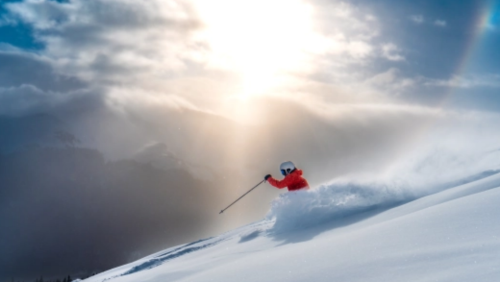Take Me to the River. . . Let’s Conserve the Water
February 13, 2023 by Allie Williams

A skiier hitting the slopes in the American Rockies after a large snowfall.
Unprecedented, warmer, wetter winter seasons have ski communities across the Alps fearful of how rising temperatures and the looming reality of climate change might impact the winter sports industry in the years to come.[1] By contrast, in the Western United States, skiers and boarders have been spoiled with powder days this season as the Rocky Mountains have been pummeled with heavy snowfalls.[2] While dense snowpacks in the Rockies are undoubtedly a godsend for powder hunters planning to hit the slopes, more importantly, the heavy snowfall provides critical relief to the nearly 36 million individuals that rely on the Colorado River Basin’s water supply.[3] High-altitude snowpacks eventually reach the Colorado River, and snowfalls have historically accounted for seventy percent of the river’s natural flow.[4] Despite this year’s heavy snowfall, the Colorado River Basin is still suffering from an ongoing “megadrought” that has diminished its water supply since the early 2000s.[5]
This historic drought has rendered the once-abundant water source on the brink of crisis. The nation’s two largest reservoirs – Lake Powell and Lake Mead – currently sit at unprecedented low levels. Lake Powell currently sits only thirty feet above the level at which it will be unable to generate hydropower.[6] Similarly, Lake Mead is dangerously close to approaching “dead pool” status, and if its water level falls below 950 feet, sources of hydroelectric power like the Hoover Dam will be incapable of generating power.[7] Local communities are already affected by pinched water supplies. The city of Scottsdale, Arizona ceased supplying water to the Rio Verde Foothills due to concerns that river basin allocations were insufficient to provide water to the residents of Scottsdale, let alone the Rio Verde Foothills.[8] As consumers continue to demand more water than river flows can currently provide, they are confronted with the harsh reality that the Colorado River’s water supply is dwindling.
This summer, the Department of the Interior issued a sixty-day deadline to negotiate a conservation plan and reduce water use by two to four million acre-feet to the seven states which depend on the Colorado River Basin for their water supply.[9] August slipped away, and the deadline came and went with no resource management plan in sight.[10] The Department of the Interior is once again asking these states to come to an agreement by January 31st to collectively cut water use by thirty percent of the reliant states’ historical use.[11] If the states fail to come to an agreement, the Department of the Interior will have to impose cuts on state water usage to save the Colorado River Basin’s water supply.[12]
Effected states have begun to consider drought-resistant water sourcing methods such as desalination, a process that removes salt and bacteria from ocean water, to lessen the region’s dependence on the Colorado River.[13] Despite improvements in desalination technology, desalination is pricey, emits greenhouse gases, and has the capacity to damage local marine ecosystems.[14] Other proposed ingenious solutions to the river basin’s management crisis include cloudseeding, which creates more snowfall by spraying certain chemical compounds into clouds to cause water particles in the air to freeze.[15]
With the January 31st deadline approaching, it remains unclear whether affected states will prove themselves capable of devising a plan to conserve the Colorado River Basin’s depleted water supply, or if a tragedy of the commons will run its course and continue to cause turmoil in the region. Regardless of whether the decades-long drought finally ceases or if negotiations prove successful, the depleted levels of the river basin and the inconsistency of winter storms make Colorado River management an uphill battle. Cooperation among key stakeholders and ingenuity in how the region can continue to access fresh water while conserving the Colorado River Basin’s water supply remains critical in years to come.
[1] Imogen Foulkes, Snow shortage threatens Alps with wet winter season, BBC News, (Jan. 3, 2023), https://www.bbc.com/news/world-europe-64151166.
[2] Alex Hager, Why heavy winter rain and snow won’t be enough to pull the West out of a megadrought, National Public Radio, (Jan. 22, 2023), https://www.npr.org/2023/01/22/1150197343/why-heavy-winter-rain-and-snow-wont-be-enough-to-pull-the-west-out-of-a-megadrou.
[3] Alex Hager, Recent heavy snow is crucial to the Colorado River but it’s not a drought ender, National Public Radio, (Jan. 19, 2023), https://www.npr.org/2023/01/19/1149924283/recent-heavy-snow-is-crucial-to-the-colorado-river-but-its-not-a-drought-ender; https://www.nature.org/en-us/about-us/where-we-work/priority-landscapes/colorado-river/#:~:text=Nearly%2036%20million%20people%20rely,%2C%20food%2C%20recreation%20and%20energy.
[4] How Much Snowpack in the Colorado River Basin Comes from Atmospheric Rivers?, Climate Program Office News, (Aug. 24, 2021), https://cpo.noaa.gov/News/ArtMID/7875/ArticleID/2362/How-much-snowpack-in-the-Colorado-River-Basin-comes-from-atmospheric-rivers.
[5] Valerie Urk, Colorado River states attempt to reach water-use plan – again, Roll Call, (Jan. 26, 2023), https://rollcall.com/2023/01/26/colorado-river-states-attempt-to-reach-water-use-plan-again/.
[6] Leia Larsen, ‘It’s a marathon, not a race’ – what Utah’s recent snowstorms mean for the Colorado River, The Salt Lake Tribune, (Jan. 9, 2023), https://www.sltrib.com/news/2023/01/09/its-marathon-not-race-what-utahs/.
[7] Christopher Flavelle, As the Colorado River Shrinks, Washington Prepares to Spread the Pain, N.Y. Times, (Jan. 28, 2023), https://www.nytimes.com/2023/01/27/climate/colorado-river-biden-cuts.html.
[8] Pandora Dewan, Is the Colorado River Drying Up?, Newsweek, (Jan. 25, 2023), https://www.newsweek.com/colorado-river-drying-lake-mead-lake-powell-1776224.
[9] Conrad Swanson, ‘We needed a deal yesterday’: Deadline passes without deal to save Colorado River. What now?, Phys.org, (Aug. 22, 2022), https://phys.org/news/2022-08-yesterday-deadline-colorado-river.html#:~:text=Trillions%20of%20gallons%20of%20water,15.
[10] Savannah Mayer, An ongoing water crisis means tough choices for Colorado River Basin states, Marketplace Morning Report, (Aug. 16, 2022), https://www.marketplace.org/2022/08/16/an-ongoing-water-crisis-means-tough-choices-for-colorado-river-basin-states/.
[11] Ella Nilsen and Rachel Ramirez, ‘The brink of disaster’: 2023 is a critical year for the Colorado River as reservoirs sink toward ‘dead pool’, CNN, (Dec. 30, 2022), https://www.cnn.com/2022/12/30/us/colorado-river-lake-mead-drought-2023-climate/index.html.
[12] Id.
[13] Emma Newburger, Why desalination won’t save states dependent on Colorado River Water, CNBC, (Jan. 27, 2023), https://www.cnbc.com/2023/01/27/why-desalination-wont-save-states-dependent-on-colorado-river-water.html.
[14] Id.
[15] Conrad Swanson, Can the West save the Colorado River before it’s too late? Here are 8 possible solutions, The Denver Post, (Jan. 4, 2023), https://www.denverpost.com/2023/01/04/colorado-river-water-cuts-crisis-solutions/

